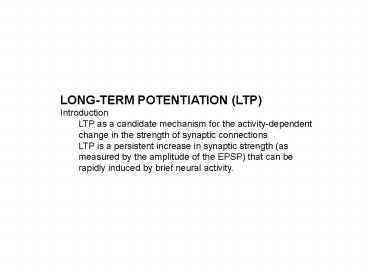LONGTERM POTENTIATION LTP - PowerPoint PPT Presentation
1 / 20
Title: LONGTERM POTENTIATION LTP
1
LONG-TERM POTENTIATION (LTP) Introduction LTP as
a candidate mechanism for the activity-dependent
change in the strength of synaptic connections
LTP is a persistent increase in synaptic
strength (as measured by the amplitude of the
EPSP) that can be rapidly induced by brief neural
activity.
2
(No Transcript)
3
(No Transcript)
4
- Anatomical background for Hippocampus
- two interlocking C-shaped regions (the
hippocampus and the dentate gurus), - main inputs entorhinal cortex
- three major afferent pathways (subiculum -gt CA1)
- Perforant pathway (subiculum -gt granule cells
in dentate gyrus) - Mossy fiber pathway (axons of the granule
cells -gt pyramidal cells in the CA3) - Schaffer collaterals (pyramidal cells in the
CA3 -gt pyramidal cells in the CA1)
5
- Perforant pathway (subiculum -gt granule
cells in dentate gyrus) - Mossy fiber pathway
- (axons of the granule cells -gt pyramidal
cells in the CA3) - Schaffer collaterals
- (pyramidal cells in the CA3 -gt pyramidal
cells in the CA1)
6
- The initial finding by Timothy Bliss and Terje
Lomo (1973) - Anaesthetized rabbit
- Brief, high-frequency stimulation of the
perforant pathway input to the dentate gyrus
produced a long lasting enhancement of the
extracellular recorded field potential.
7
Recording techniques In vivo (in awake and
freely moving animals, or in anesthetized
animals) in vitro (slice preparations)
Extracellar recordings intracellular recordings
Experimental design Stimulation of a bundle of
presynaptic axons recording of monosynaptic EPSP
Typical results for induction of LTP
8
(No Transcript)
9
(No Transcript)
10
(No Transcript)
11
(No Transcript)
12
- The "classical properties" of LTP
- Cooperativity
- The probability of inducing LTP, or the magnitude
of the resulting change, increases with the
number of stimulated afferents. - Associativity
- associativity was shown in preparations in
which two distinct axonal inputs converged onto
the same postsynaptic target - Concurrent stimulation of weak and strong
synapses to a given neuron strengthens the weak
ones. - Input specificity
- LTP is restricted to only the inputs that
received the tenanic (high-frequency) stimulation
13
(No Transcript)
14
(No Transcript)
15
- Underlying molecular mechanisms
- Introduction
- LTP requires some sort of additive effect
- High-frequency stimulation
- Activation of synapses and depolarization of the
postsynaptic neuron must occur at the same time - LTP (in area CA1) depends on certain changes at
glutamate synapses, - Types of glutamate receptors
- NMDA receptors
- Non-NMDA receptors
- At non-NMDA receptors,
- glutamate is excitatory
- Open channels for sodium ions
16
- At NMDA receptors,
- Controls a calcium ion channel
- glutamate is neither excitatory nor inhibitory
- Ion channel is blocked by magnesium ions
- Activation of NMDA receptors requires both
glutamate and depolarization, which lead to the
removal of magnesium ions - The NMDA receptors now respond actively to
glutamate and admit large amount of Ca2 through
their channels - After induction of LTP, transmission at non-NMDA
receptors is facilitated
17
(No Transcript)
18
(No Transcript)
19
- LTP is induced via a cascade of neurochemical
steps - The entry of Ca2 ions into neurons activates
some protein kinases (which are enzymes that
catalyze phosphorylation, the addition of
phosphate groups to protein molecules). - One of the kinase, Calcium-calmodulin kinase (CaM
kinase) remains activated once it is put into
that state by Ca2, even if the level of Ca2
subsequently falls - The activated protein kinases also trigger the
synthesis of proteins - activate cAMP responsive element-binding protein
(CREB) - CREB -gt production of the transcription (mRNA) of
immediate early genes (IEGs) -gt regulate the
expression of particular late effector genes
(LEGs) -gt synthesis of proteins - Induction of LTP requires a retrograde signal,
from the postsynaptic neuron to the presynaptic
neuron
20
(No Transcript)































